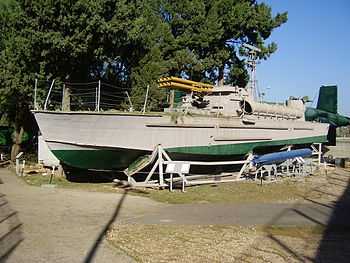P 4-class torpedo boat
 Basis of the P4, Soviet K-123 type formerly with the Egyptian navy; at display at the Ha'apala and Israeli Navy museum, Haifa, Israel | |
| Class overview | |
|---|---|
| Operators: |
|
| General characteristics | |
| Type: | Torpedo boat |
| Displacement: | 19.5 tonnes (19.2 long tons; 21.5 short tons) |
| Length: | 19.3 m (63 ft 4 in)[1] |
| Beam: | 3.7 m (12 ft 2 in) |
| Draft: | 1 m (3 ft 3 in) |
| Propulsion: | 2 × Soviet M50 diesel engines, 2,400 hp (1,790 kW), 2 shafts |
| Speed: | 55 knots (102 km/h; 63 mph) |
| Range: | 500 mi (800 km) |
| Complement: | 12 |
| Sensors and processing systems: | 1 × Soviet I band Skin Head navigational radar |
| Armament: | 2 × 450 mm (17.7 in) torpedoes 2 × 12.7 mm (0.50 in) or 14.5 mm (0.57 in) heavy machine guns |
The P 4 class torpedo boat (TB) were aluminum-hulled torpedo boats of the People's Republic of China's People's Liberation Army Navy. Based on the Soviet K-123 hydroplane design, they were armed with twin 14.5-millimetre (0.57 in) machine guns,[2] and two 17-inch (43 cm) torpedoes. This class is currently considered obsolete, but was not completely retired from active service, being placed in reserve until the mid-1990s.
The P 4 torpedo boats consisted of two primary types; the K-123 type with radar, and B-123 type without. The Chinese-built units made the radar standard for all boats, and replaced the original 12.7-millimetre (0.50 in) heavy machine guns onboard those former Soviet boats delivered to China with 14.5-millimetre (0.57 in) heavy machine guns.
The PLAN transferred this class to the naval militia for training purposes, and because these boats are kept and maintained on land due to their small size, they are normally in better condition than larger units that are kept in the reserve and mothballed fleets.
In addition to naval militia training duties, some of the surviving units have been converted into target drones, and have thus been returned to active service, functioning as minor support auxiliaries. As with the Yulin-class gunboat, the drone is controlled by larger converted gunboats such as the Shantou, Huangpu, and Beihai classes. When in operation as drones, the boats are unmanned.
P 6-class torpedo boat
P 6-class torpedo boat ("Project 183 Bolshevik") is a development of P 4-class TB originally intended to be a successor of P 4, but instead, it complemented P 4 when both types served together along with each other. As with P 4 class, P 6-class also comes in two version, one with radar and the other without, 183T and 183 respectively. P 6 class TB is larger than P 4-class TB, with sized increased by 3 times and is more heavily armed, with two 21-in torpedoes replaced the 18-in torpedoes of P 4-class, and twin 25 mm gun mounts replaced 14.5 mm gun mounts of P 4-class.[3]
- Length: 25.4 m
- Width: 6.24
- Draft: 1.24
- Displacement: 66.5 t full
- Max speed: 44 kn max
- Endurance: 1000 nmi @ 14 kn or 600 nmi @ 33 kn
- Propulsion: four diesel engines @ 1200 horsepower each
- Armaments:
- Two 533 mm torpedoes
- Four 25 mm guns (II x 2), with 1000 rounds of ammo
- 8 depth charges
- Units built: 560 total (for former-USSR)
P 8-class torpedo boat
P 8-class torpedo boat is another development of P 6-class TB, which is a P 4-class with hydrofoil added. Although only a small number was built for the Soviet Navy, a large number of its derivative was built by Chinese as Type 025-class torpedo boat.
P 10-class torpedo boat
P 10-class torpedo boat was an experimental boat based on P 6-class, and it was a P 6-class powered by gasturbine engine to evaluate the its feasibility of gasturbine engine for maritime use.
Variants
- B-123: also known as 123B, P 4-class torpedo boat without the radar.
- K-123: also known as 123K, P 4-class torpedo boat with the radar added.
- Project 183: P 6-class torpedo boat without the radar.
- Project 183T: Project 183 P 6-class torpedo boat with radar added.
- P 8-class torpedo boat: P 6-class torpedo boat with hydrofoil added.
- P 8-class torpedo boat: P 6-class torpedo boat with gasturbine engine installed for evaluation.
References
- Notes
- ↑ Moïse 1996, p. 70
- ↑ Moïse 1996, p. 71
- ↑ P 6-class torpedo boat
- Bibliography
- Moïse, Edwin E. (1996). Tonkin Gulf and the Escalation of the Vietnam War. Chapel Hill: The University of North Carolina Press. ISBN 0-8078-2300-7.
| ||||||||||||||||||||||||||||||||||||||||||||||||||||||||||||||||||||||||||||||||||||||||||||||||||||||||